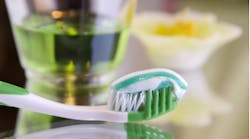Hygiene Message in a Bottle Mailbag: Remineralizing root surfaces
The Hygiene Message in a Bottle Mailbag is a monthly feature of the e-newsletter, Pearls for Your Practice: The Product Navigator. Each month, Colleen Olson, RDH, BBA, the editorial director of the Hygiene Product Navigator, will answer reader-submitted questions to help you navigate your dental hygiene product decisions (and more!). This month, she discusses the process of remineralization and recommends remineralizing products.
KD wrote: Is remineralization possible for root surfaces or just enamel?
Answer
Dental hygienists most often focus their efforts on reducing caries risk. One important facet of dental hygiene is prevention, and we aim to prevent decay at the earliest possible stage. Teeth are in a constant state of demineralization and remineralization. The management of host factors, oral hygiene, and use of remineralizing agents can all help arrest incipient lesions and reduce the risk of decay.
Remineralization is a slower process than demineralization in both enamel and dentin. The structure of dentin degrades more rapidly than enamel in acidic environments, which is why decay progresses much more quickly once it reaches the dentin. (1) Under the right conditions and over an appropriate amount of time, remineralization can repair damage caused by demineralization, but these optimal conditions are different for every patient.
In researching this question I came across this small but interesting study that compared the number of fluoride moments per day—two versus three—on both dentin and enamel. (2) Sixteen participants wore small enamel and dentin discs with preformed lesions in prostheses. The participants were divided into placebo and treatment groups. Both groups brushed twice a day with a 1400 ppm fluoride toothpaste, and the treatment group rinsed once a day with a 250 ppm fluoride rinse. Upon analysis, in the treatment group with three fluoride moments a day, the dentin discs had a statistically significant increase in structurally bound fluoride, compared to the placebo control group with only two fluoride moments per day.
This study helps confirm that the more we do to help patients prevent demineralization of both enamel and dentin, the better. Fluoride therapy is just one option. We can do this by helping patients with managing risk factors such as xerostomia, providing instruction on how to improve home care and diet, and applying and recommending remineralizing products.
Products that have demonstrated effectiveness in root caries prevention and arrest include fluoride varnishes, rinses, and gels; chlorhexidine varnish; xylitol chewing gums; and potentially products containing calcium and phosphate. (3) In the end, none of these things may fully prevent decay either in enamel or on root surfaces, but they can help reduce caries risk overall, and that is a worthy goal for us to work toward.
References
1. Amaechi BT, van Amerongen J, van Loveren C, Kidd EM. Caries management: diagnosis and treatment strategies. In: Hilton TJ, Ferracane JL, Broome J, eds. Summitt's Fundamentals of Operative Dentistry: A Contemporary Approach. 4th ed. Hanover Park, IL: Quintessence Publishing Co; 2013:93-130.
2. Laheij A, Strijp AV, Loveren CV. In situ remineralisation of enamel and dentin after the use of an amine fluoride mouthrinse in addition to twice daily brushings with amine fluoride toothpaste [abstract]. Caries Res. 2010;44(3):184-190. doi:10.1159/000314673.
3. Matis BA, Gonzalez-Cabezas C, Cochran MA. Diagnosis and treatment of root caries. In: Hilton TJ, Ferracane JL, Broome J, eds. Summitt's Fundamental of Operative Dentistry: A Contemporary Approach. 4th ed. Hanover Park, IL: Quintessence Publishing Co; 2013:369-379.
More reading
July 2017 | Updated guidelines on fruit juice for infants, children, adolescents
June 2017 | Recommendations for take-home whitening products and whitening toothpaste
May 2017 | Products for sensitivity relief when preprocedural paste and fluoride varnish aren't enough
Editor's note: Do you have a question for Colleen? Is there a product you'd like to see her review? Or would you like to submit your own hygiene product article? Send an e-mail to [email protected]. You might just see it in the Hygiene Product Navigator! If you're not a Product Navigator subscriber, click here to sign up.
For the most current dental product articles, click here.
For the most current dental headlines, click here.
About the Author

Colleen Olson, RDH, BBA
Editorial Director
Colleen M. Olson, RDH, BBA, is an editorial director for the e-newsletter, Pearls for Your Practice: The Hygiene Product Navigator. She earned a bachelor's degree in business administration from Texas A&M University in 2008 and worked in sales for five years. She graduated from the Blinn College Dental Hygiene program in 2013. She is a full-time mom to Bonnie Grace and is currently a part-time hygienist in private practice in San Antonio, Texas. She enjoys spending time outdoors with her husband, Zach, and their families.


